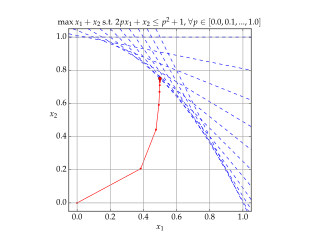To ensure that the global maximum of a non-linear problem can be identified easily, the problem formulation often requires that the functions be convex and have compact lower level sets. This is the significance of the Karush–Kuhn–Tucker conditions. They provide necessary conditions for identifying local optima of non-linear programming problems. There are additional conditions (constraint qualifications) that are necessary so that it will be possible to define the direction to an optimal solution. An optimal solution is one that is a local optimum, but possibly not a global optimum.
Lagrange duality
Motivation. [17] Suppose we want to solve the following nonlinear programming problem:

The problem has constraints; we would like to convert it to a program without constraints. Theoretically, it is possible to do it by minimizing the function J(x), defined as

where I is an infinite step function: I[u]=0 if u≤0, and I[u]=∞ otherwise. But J(x) is hard to solve as it is not continuous. It is possible to "approximate" I[u] by λu, where λ is a positive constant. This yields a function known as the lagrangian:

Note that, for every x,
 .
.
Proof:
- If x satisfies all constraints fi(x)≤0, then L(x,λ) is maximized when taking λ=0, and its value is then f(x);
- If x violates some constraint, fi(x)>0 for some i, then L(x,λ)→∞ when λi→∞.
Therefore, the original problem is equivalent to:
 .
.
By reversing the order of min and max, we get:
 .
.
The dual function is the inner problem in the above formula:
 .
.
The Lagrangian dual program is the program of maximizing g:
 .
.
The optimal solution to the dual program is a lower bound for the optimal solution of the original (primal) program; this is the weak duality principle. If the primal problem is convex and bounded from below, and there exists a point in which all nonlinear constraints are strictly satisfied (Slater's condition), then the optimal solution to the dual program equals the optimal solution of the primal program; this is the strong duality principle. In this case, we can solve the primal program by finding an optimal solution λ* to the dual program, and then solving:
 .
.
Note that, to use either the weak or the strong duality principle, we need a way to compute g(λ). In general this may be hard, as we need to solve a different minimization problem for every λ. But for some classes of functions, it is possible to get an explicit formula for g(). Solving the primal and dual programs together is often easier than solving only one of them. Examples are linear programming and quadratic programming. A better and more general approach to duality is provided by Fenchel's duality theorem. [18] : Sub.3.3.1
Another condition in which the min-max and max-min are equal is when the Lagrangian has a saddle point: (x∗, λ∗) is a saddle point of the Lagrange function L if and only if x∗ is an optimal solution to the primal, λ∗ is an optimal solution to the dual, and the optimal values in the indicated problems are equal to each other. [18] : Prop.3.2.2
The strong Lagrange principle
Given a nonlinear programming problem in standard form

with the domain  having non-empty interior, the Lagrangian function
having non-empty interior, the Lagrangian function is defined as
is defined as

The vectors  and
and  are called the dual variables or Lagrange multiplier vectors associated with the problem. The Lagrange dual function
are called the dual variables or Lagrange multiplier vectors associated with the problem. The Lagrange dual function is defined as
is defined as

The dual function g is concave, even when the initial problem is not convex, because it is a point-wise infimum of affine functions. The dual function yields lower bounds on the optimal value  of the initial problem; for any
of the initial problem; for any  and any
and any  we have
we have  .
.
If a constraint qualification such as Slater's condition holds and the original problem is convex, then we have strong duality, i.e.  .
.
Convex problems
For a convex minimization problem with inequality constraints,

the Lagrangian dual problem is

where the objective function is the Lagrange dual function. Provided that the functions  and
and  are continuously differentiable, the infimum occurs where the gradient is equal to zero. The problem
are continuously differentiable, the infimum occurs where the gradient is equal to zero. The problem

is called the Wolfe dual problem. This problem may be difficult to deal with computationally, because the objective function is not concave in the joint variables  . Also, the equality constraint
. Also, the equality constraint  is nonlinear in general, so the Wolfe dual problem is typically a nonconvex optimization problem. In any case, weak duality holds. [19]
is nonlinear in general, so the Wolfe dual problem is typically a nonconvex optimization problem. In any case, weak duality holds. [19]



















































